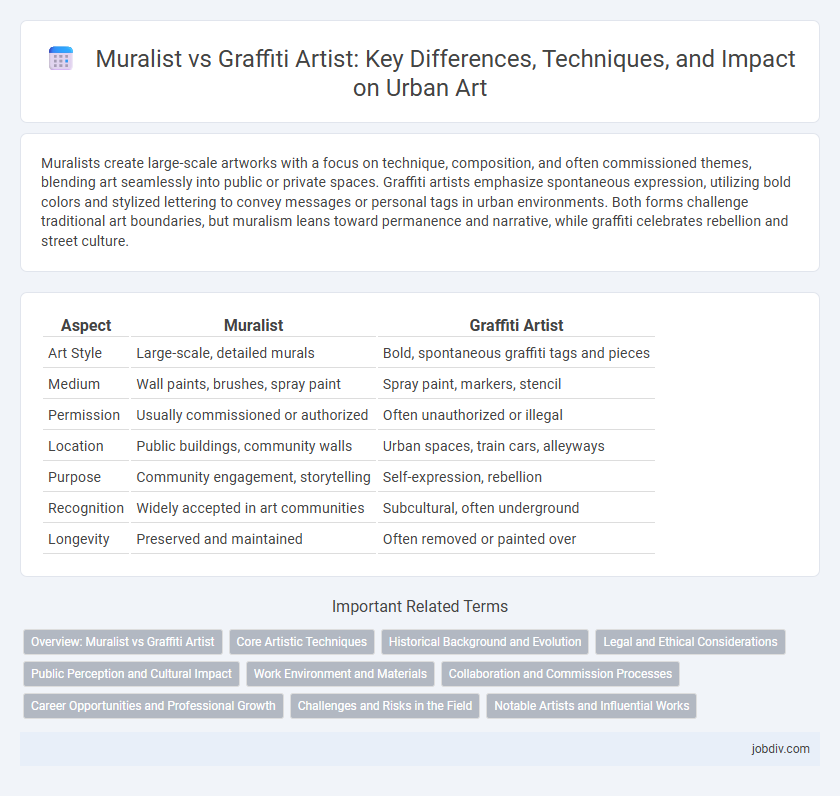Muralists create large-scale artworks with a focus on technique, composition, and often commissioned themes, blending art seamlessly into public or private spaces. Graffiti artists emphasize spontaneous expression, utilizing bold colors and stylized lettering to convey messages or personal tags in urban environments. Both forms challenge traditional art boundaries, but muralism leans toward permanence and narrative, while graffiti celebrates rebellion and street culture.
Table of Comparison
| Aspect | Muralist | Graffiti Artist |
|---|---|---|
| Art Style | Large-scale, detailed murals | Bold, spontaneous graffiti tags and pieces |
| Medium | Wall paints, brushes, spray paint | Spray paint, markers, stencil |
| Permission | Usually commissioned or authorized | Often unauthorized or illegal |
| Location | Public buildings, community walls | Urban spaces, train cars, alleyways |
| Purpose | Community engagement, storytelling | Self-expression, rebellion |
| Recognition | Widely accepted in art communities | Subcultural, often underground |
| Longevity | Preserved and maintained | Often removed or painted over |
Overview: Muralist vs Graffiti Artist
Muralists create large-scale paintings designed to enhance public spaces, often working with permission and emphasizing detailed, planned compositions that reflect cultural or social themes. Graffiti artists typically produce spontaneous, stylized markings or images in urban environments, often without authorization, highlighting personal expression and countercultural messages. Both art forms contribute to public art culture but differ in intent, technique, and legal status.
Core Artistic Techniques
Muralists utilize large-scale brushwork, layering, and precise color blending to create detailed, planned compositions often integrated with architectural elements. Graffiti artists emphasize spray paint techniques, stenciling, and dynamic lettering styles that prioritize speed, improvisation, and bold visual impact. Both disciplines rely on mastery of form, color theory, and spatial awareness but differ in execution tools and intended public engagement.
Historical Background and Evolution
Muralists trace their origins to ancient civilizations where large-scale wall paintings served religious and cultural purposes, evolving through Renaissance fresco techniques to modern public art commissions. Graffiti artists emerged from urban street culture in the late 20th century, using spray paint to create spontaneous, often politically charged works that challenged traditional art boundaries. Both forms reflect distinct historical trajectories: murals rooted in formal artistic traditions and graffiti embodying rebellious, grassroots expression.
Legal and Ethical Considerations
Muralists typically create large-scale artworks with permission on public or private property, ensuring adherence to legal frameworks and community standards, which fosters positive cultural engagement. Graffiti artists often operate in unauthorized spaces, raising ethical concerns about property rights, vandalism, and the potential for criminal charges despite the artistic value of their work. Navigating the balance between artistic expression and respecting legal boundaries remains crucial for both muralists and graffiti artists in urban art landscapes.
Public Perception and Cultural Impact
Muralists are often perceived as legitimate artists commissioned to create large-scale, community-enhancing works that celebrate cultural heritage and urban identity, contributing positively to public spaces. Graffiti artists, meanwhile, face mixed public perceptions; their work can be seen as rebellious or vandalism, yet it also embodies potent forms of social commentary and youth culture expression. Both art forms significantly impact cultural discourse by challenging traditional definitions of art and democratizing creative expression in public environments.
Work Environment and Materials
Muralists typically work on large-scale public or private walls using traditional materials like brushes, rollers, and exterior-grade acrylic paints for durability and precision. Graffiti artists often create spontaneous, improvisational pieces in urban environments using spray paint, markers, and stencils to achieve vibrant, quick-executed styles. Both art forms require adaptability to varying surfaces and weather conditions but differ significantly in their preparation, technique, and public reception.
Collaboration and Commission Processes
Muralists and graffiti artists often collaborate with city officials, businesses, and community groups to secure commissions that balance artistic vision with public appeal. The commission process for muralists typically involves detailed proposals, permits, and budget approvals, while graffiti artists may participate in more spontaneous, community-led projects or sanctioned street art programs. Both disciplines enhance urban environments through large-scale visuals but differ in formal engagement, with muralists favoring structured agreements and graffiti artists embracing grassroots collaboration.
Career Opportunities and Professional Growth
Muralists typically secure commissioned projects from businesses, municipalities, and art institutions, offering stable income and opportunities for public recognition. Graffiti artists often build their reputation through street credibility and social media, leading to collaborations with brands and galleries. Both career paths demand evolving skills and networking, but muralists may find more institutional support and long-term professional growth.
Challenges and Risks in the Field
Muralists often face challenges related to securing legal permits and funding, with high costs for materials and the need for large-scale project approvals. Graffiti artists encounter significant legal risks, including fines, arrests, and potential criminal records, as their work frequently involves unauthorized public spaces. Both disciplines grapple with public perception issues, balancing artistic expression against vandalism accusations.
Notable Artists and Influential Works
Notable muralists like Diego Rivera and Jose Clemente Orozco transformed public spaces with large-scale, politically charged frescoes that narrate cultural history. In contrast, influential graffiti artists such as Banksy and Jean-Michel Basquiat gained fame for their provocative street art that challenges social norms and brings contemporary issues into urban landscapes. These artists' works continue to shape the dialogue between traditional muralism and modern graffiti, highlighting the evolution of public art forms.
Muralist vs Graffiti Artist Infographic

 jobdiv.com
jobdiv.com